By: Indra Starke-Ottich(Editor), Dirk Bönsel(Editor), Thomas Gregor(Editor), Andreas Malten(Editor), Christina Müller(Editor), Georg Zizka(Editor)
276 pages, 229 colour illustrations, 9 tables
![Stadtnatur im Wandel Stadtnatur im Wandel]()
Click to have a closer look
About this book
Contents
Customer reviews
Related titles
About this book
Language: German
"Times, they are a-changing, and we change with them". This saying is true not only for humans, but for the whole of nature But what changes can be observed in the urban nature in Frankfurt, Germany? What causes these changes and what effects are they having? Since 1985 the "Arbeitsgruppe Biotopkartierung der Abteilung Botanik des Senckenberg Forschungsinstitutes und Naturmuseums Frankfurt" (the working group biotope mapping of the Botany Department of the Senckenberg Research Institute and Natural History Museum of Frankfurt) are investigating biodiversity in Frankfurt am Main on behalf of the German Environmental Agency.
Current results show which changes can be observed in the town's nature and what is causing them. The role of immigration and the emergence of new species in urban spaces is shown. The "comings and goings" of plants are reported. Separate chapters are devoted to the wildlife (dragonflies, butterflies, fish and the European hamster Cricetus cricetus) and fungi of this city – which show a surprising variety and amazing special features. In "City Nature in Portrait", natural habitats of special interest are presented, such as the Harheimer Ried, the Heiligenstock, the Schwanheimer meadows and the Nidda-shore.
The book offers numerous opportunities to learn more details about the biodiversity in Frankfurt – right outside of one's front door. A total of 229 colour images illustrate this diversity and make it easier discover and recognize it for oneself. Extensive lists of species recorded are given in the appendix and are published in this book for the first time in their completeness. Three guided walks along the river invite all city dwellers, and nature lovers to explore the amazing biodiversity of this region.
Summary in German:
"Die Zeiten ändern sich und wir mit ihnen.“ Dieses Sprichwort gilt nicht nur für den Menschen, sondern für die gesamte Natur! Doch welche Veränderungen sind in der Stadtnatur Frankfurts zu beobachten? Wodurch werden sie hervorgerufen und welche Auswirkungen haben sie? Seit 1985 untersucht die Arbeitsgruppe Biotopkartierung der Abteilung Botanik des Senckenberg Forschungsinstitutes und Naturmuseums Frankfurt die Artenvielfalt in Frankfurt am Main im Auftrag des Umweltamtes.
Aktuelle Ergebnisse zeigen, welche Veränderungen in der Stadtnatur zu beobachten sind und wodurch sie hervorgerufen werden. Die Rolle von Einwanderung und Entstehung neuer Arten im urbanen Raum wird aufgezeigt. Vom "Kommen und Gehen“ der Pflanzen wird berichtet. Der Tierwelt (Libellen, Schmetterlinge, Fische und Feldhamster) und den Pilzen im Stadtgebiet – mit einer überraschenden Vielfalt und erstaunlichen Besonderheiten – sind eigene Kapitel gewidmet. In "Stadtnatur im Portrait“ werden mit dem Harheimer Ried, dem Heiligenstock, den Schwanheimer Wiesen und dem Nidda-Ufer naturnahe und besonders interessante Lebensräume vorgestellt.
Das Buch bietet zahlreiche Möglichkeiten, Genaueres über die Artenvielfalt in Frankfurt zu erfahren – direkt vor der Haustür! 229 farbige Abbildungen illustrieren diese Vielfalt und erleichtern das eigene Entdecken und Wiedererkennen. Umfangreiche Listen der gefundenen Arten sind im Anhang zusammengestellt und werden in diesem Buch zum ersten Mal in dieser Vollständigkeit veröffentlicht. Drei geführte Spaziergänge am Fluss laden alle Großstädter, Naturfreunde und Neugierige dazu ein, die erstaunliche Artenvielfalt der Region hautnah zu erkunden.
Contents
NEUE EINBLICKE IN DIE STADTNATUR
FRANKFURTER FLORA IM WANDEL
/ Vom Kommen und Gehen der Pflanzen
/ Frisch eingetroffen – pflanzliche Einwanderer
/ Neoendemiten – Evolution vor der Haustür
/ Farbenfrohe Neuheiten auf Frankfurter Friedhöfen
/ Ackerwildkräuter – Begleiter unserer Kultur
TIERISCHE BESONDERHEITEN IN FRANKFURT AM MAIN
/ Libellen – bedrohte Kunstflieger
/ Schmetterlinge – Vielfalt einst und jetzt
/ Fische – stilles Leben in Frankfurts Gewässern
/ Feldhamster – vom Ernteschädling zur gefährdeten Art
ÜBERRASCHENDE VIELFALT: PILZE IN FRANKFURT AM MAIN
/ Ein Leben im Verborgenen
/ Pilzvorkommen im Frankfurter Stadtwald
/ Wiesenpilze im Stadtgebiet
/ Von Überlebenskünstlern, Neubürgern und lebenden Fossilien
STADTNATUR IM PORTRAIT
/ Der Heiligenstock – wertvolle Biotope rund um Eselsweg und Zollhaus
/ Das Harheimer Ried – Frankfurts jüngstes Naturschutzgebiet
/ Die Nidda-Ufer in Frankfurt – Lebensraum für Neubürger
und gefährdete Arten
/ Die Schwanheimer Wiesen – Frankfurts größte Waldwiese
BIODIVERSITÄT ERLEBEN: SPAZIERGÄNGE AM FLUSS
/ Die Nidda im Norden – von Berkersheim zum Alten Flugplatz
/ Die Nidda und ihre Altarme – zwischen Nied und Sossenheim
/ Die Wörthspitze – wo Nidda und Main sich vereinen
AUSBLICK: WANDEL UND WACHSTUM
"FLORA VON FRANKFURT“ ONLINE – WAS SIE SCHON IMMER ÜBER UNSERE PFLANZEN WISSEN WOLLTEN
LITERATUR
ANHANG
Customer Reviews
By: Indra Starke-Ottich(Editor), Dirk Bönsel(Editor), Thomas Gregor(Editor), Andreas Malten(Editor), Christina Müller(Editor), Georg Zizka(Editor)
276 pages, 229 colour illustrations, 9 tables






































